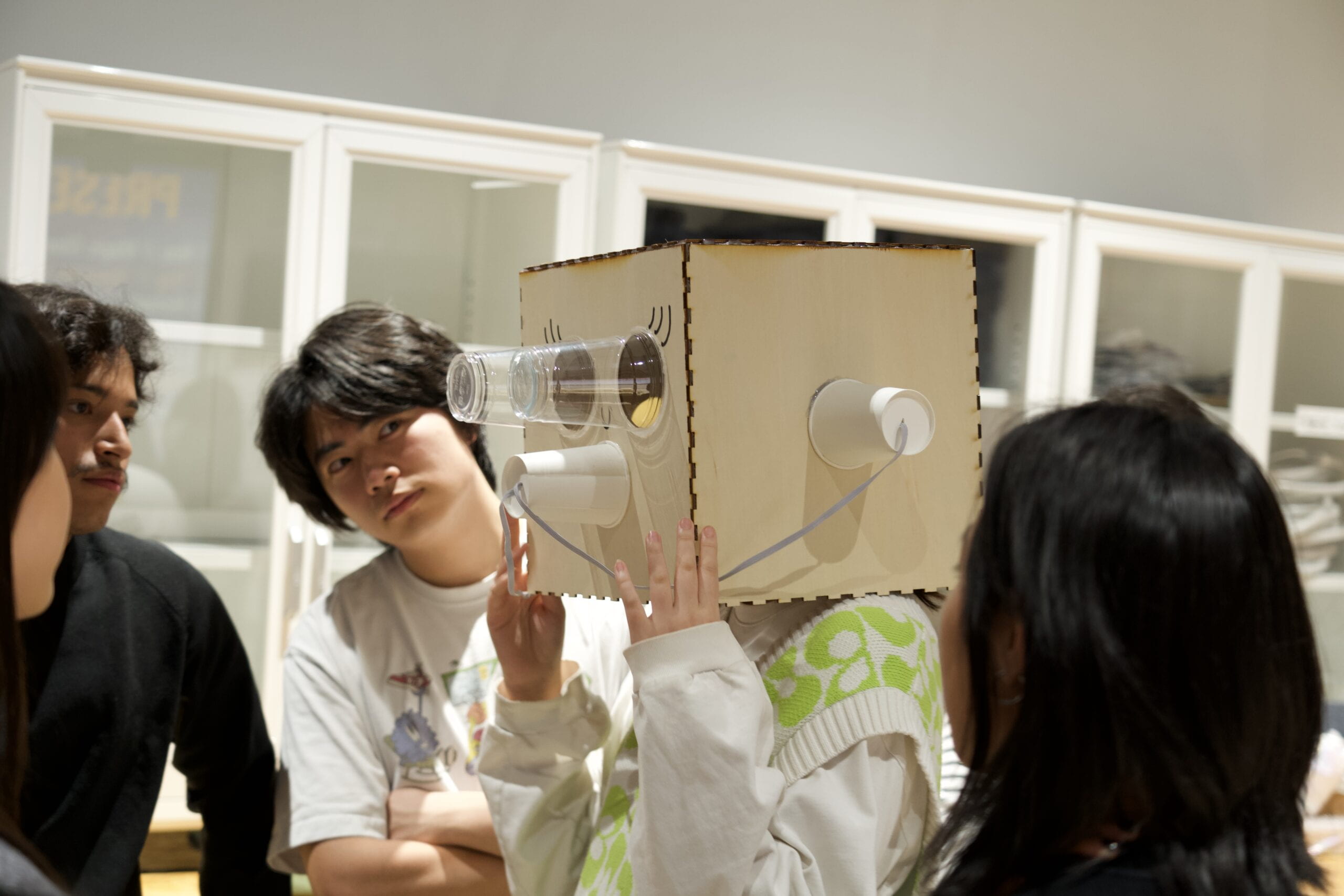
Echo Helmet – Jingchen Gao – Eric Parren
I. Project Introduction & Description:
The Echo Helmet is a wearable device aimed to create the echo of one’s own sound within the helmet. By using materials like wood boards and disposable cups, one’s sound can form echoes when it encounters these materials, and they can be further amplified by traveling and reverberating through the space between these materials and therefore reach the effect of amplifying one’s own sound when the person is speaking and listening to his / her voice. Besides, the two transparent cups in front of the eyes can also distort the eyesight to some extent because of the uneven surface on the bottom of the cup.
My intention of making this device is to try to combine our two perceptions – seeing and hearing together and create a semi-enclosed space where we can temporarily isolate ourselves from the outside world and spend time focusing on ourselves and listen to our inner voices. Nowadays as social media is occupying every aspect of our lives and the term “social contact” has extended to both online and offline domains, we spend most of our time either chatting with others on our phones or talking with our friends face to face, and the time we spent alone reflecting on ourselves has been largely reduced. Therefore, by combining the ideas of distorting different modalities of our perception and creating a physically semi-closed space where we can be temporarily cut off from external information, I finally decided to choose this “Echo Helmet” instead of my other options.
II. Perspective & Context
This project is deeply related with our sensory functions and is aimed at combining creation, art and our daily sensory feelings together. Before starting to design this project, I first watched the videos about synesthesia (https://www.youtube.com/watch?v=s32v0rTkey4) and the theory of Merleau-Ponty (https://www.youtube.com/watch?v=JFj8kWm_N-Y). The contents of these videos, though largely differ from each other, were both related to our sensory feelings. In the first video, the speaker claimed that synesthesia happens when one can relate two (or more) sensory feelings together and utilize one to help the other. For example, he mentioned that some people can relate words or numbers with colors or relate different sounds with certain tastes. This special ability may be inborn or cultivated at a young age and usually accompanies the person for the entire life. In the second video which was a brief but insightful introduction to the most crucial theory of Merleau-Ponty, the speaker pointed out that in Merleau-Ponty’s point of view, our thoughts, perceptions and experiences are deeply related to our bodily experiences, which means that we cannot be totally separated from our bodies when forming the cognition of the world as if we are treating things in a totally objective way. Instead, we should focus on our bodily movements and experiences as well. He is against the traditional “dualism” between our minds and bodies and appeal that we should utilize our bodies to actively engage with the external world.
I also read Robert Irwin’s essay “The Process of Compounded Abstraction- Notes Toward a Model” (https://drive.google.com/file/d/10IffU7CT0TfDZ20RFZAqbBnHbLkMrVse/view). In his article, Irwin argues that instead of simply being a process of simplification and reduction, abstraction should involve deeper complexities. This requires our own understanding of the subject, therefore our concept and perception play an important role in the process of abstraction. His idea is somehow similar with the idea of Merleau-Ponty’s, because in my personal understanding both of them agree that our perception of one thing is deeply related to our direct engagement with it and that in-person interaction is very crucial when shaping our understanding and thoughts of an external object.
These ideas benefited me a lot. Firstly, the idea of synesthesia inspired me to connect two different sensory feelings – hearing and seeing – together, and to make a device that could distort both of them at the same time to provoke some connection between the feelings. I also got a new idea of how our bodily experiences may affect our perception, so that’s part of the reason why I created a wearable device to directly relate our bodies with our perceptions of the external world. However, when writing this documentation, I do feel that my project lacks the interaction that is highly emphasized in the second video and the reading, because my project does not include the person’s active and initiative engagement with the external world and other people, and therefore the distortion of our perception modalities may only be limited to a small range. I think that although I did try to combine our bodily experiences with our perception and created a connection like synesthesia, I can go further by involving more interactive process in the future since that is a crucial element when experiencing art too.
III. Development & Technical implementation

Before starting to do hands-on fabrications, I first tried to come up with some ideas that fulfilled the requirements. After being inspired by the “paper cup telephone” which I used to play with when I was a child, I decided to use two kinds of disposable cups and combine them together by creating a wearable wooden box. Above is my draft about this idea. During the drafting process I did not think of using the transparent cups in front of the eyes, but later I added them due to three reasons: the transparent cups were available at the cafeteria and broke my limited previous perception that disposable cups were all paper-made; if I didn’t block the two openings I designed for seeing, the echo effect would be greatly reduced because the space was not enclosed any longer and it would be easy to exchange sound through the helmet; the two transparent cups could also fulfill the purpose of distorting one’s vision. Therefore, my final project includes two kinds of disposable cups attached to a wooden helmet.
Then it came to the fabrication process. In the beginning I thought of using cardboard to build the helmet, but after trying I gave up and turned to the 3mm wood boards. The cardboard was too hard to be cut into pieces of the exact same size, and if the pieces were not of the same size, then it would be difficult to glue them together and create a box without a lid. Meanwhile, the cardboard was softer than the plank and was not smooth and hard enough to generate echoes. As a result, I turned to wood and used laser cutting to create the wood boards. I first used the cardboard to formulate the size of each possible hole that needed to be cut, and then went to cuttle.xyz to generate the file for laser cutting. Below is a screenshot of this file.
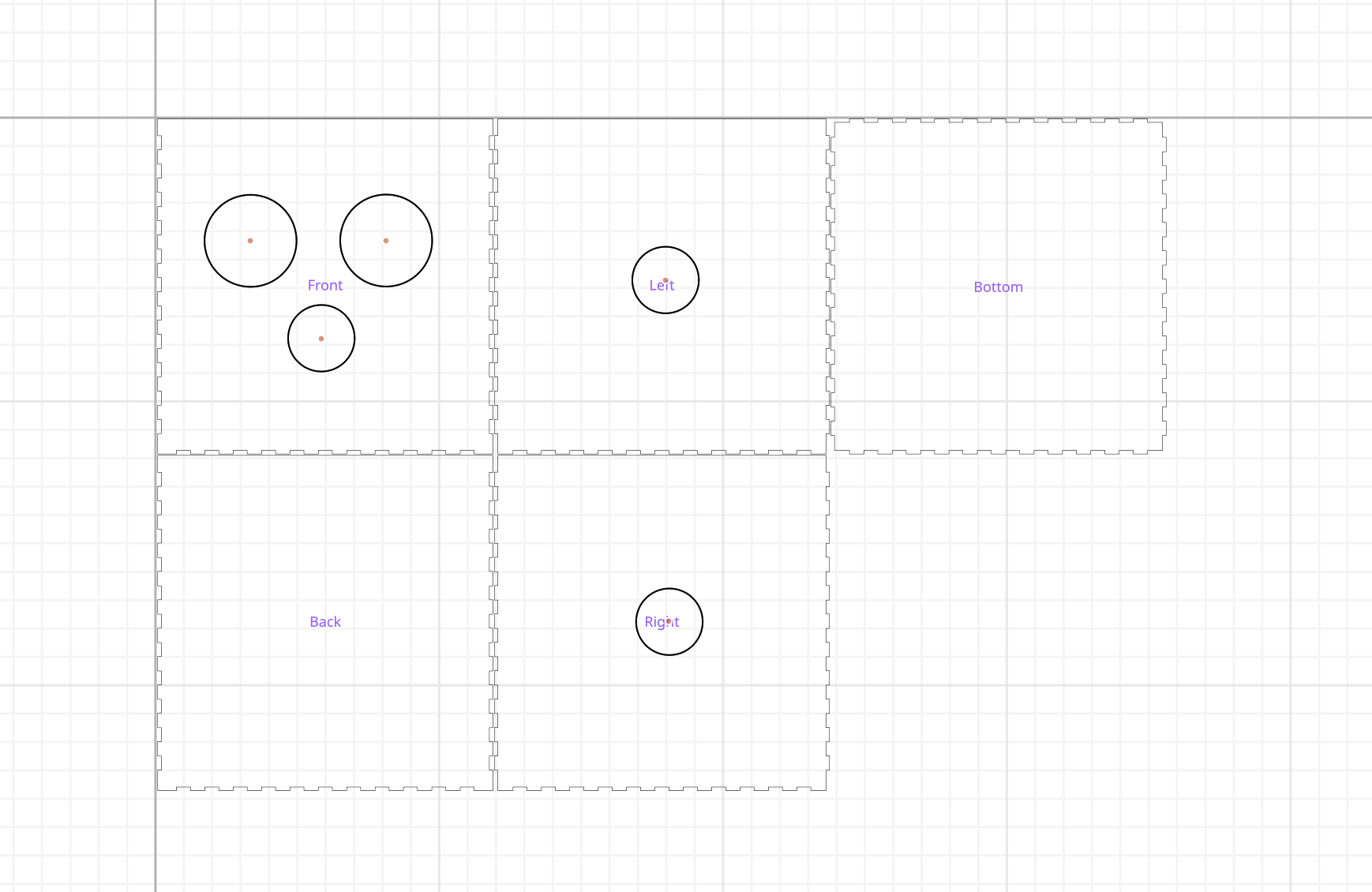
After that, I went to the Fabrication Lab and cut the wood boards under the help of a professor. I glued them together and added the disposable cups.
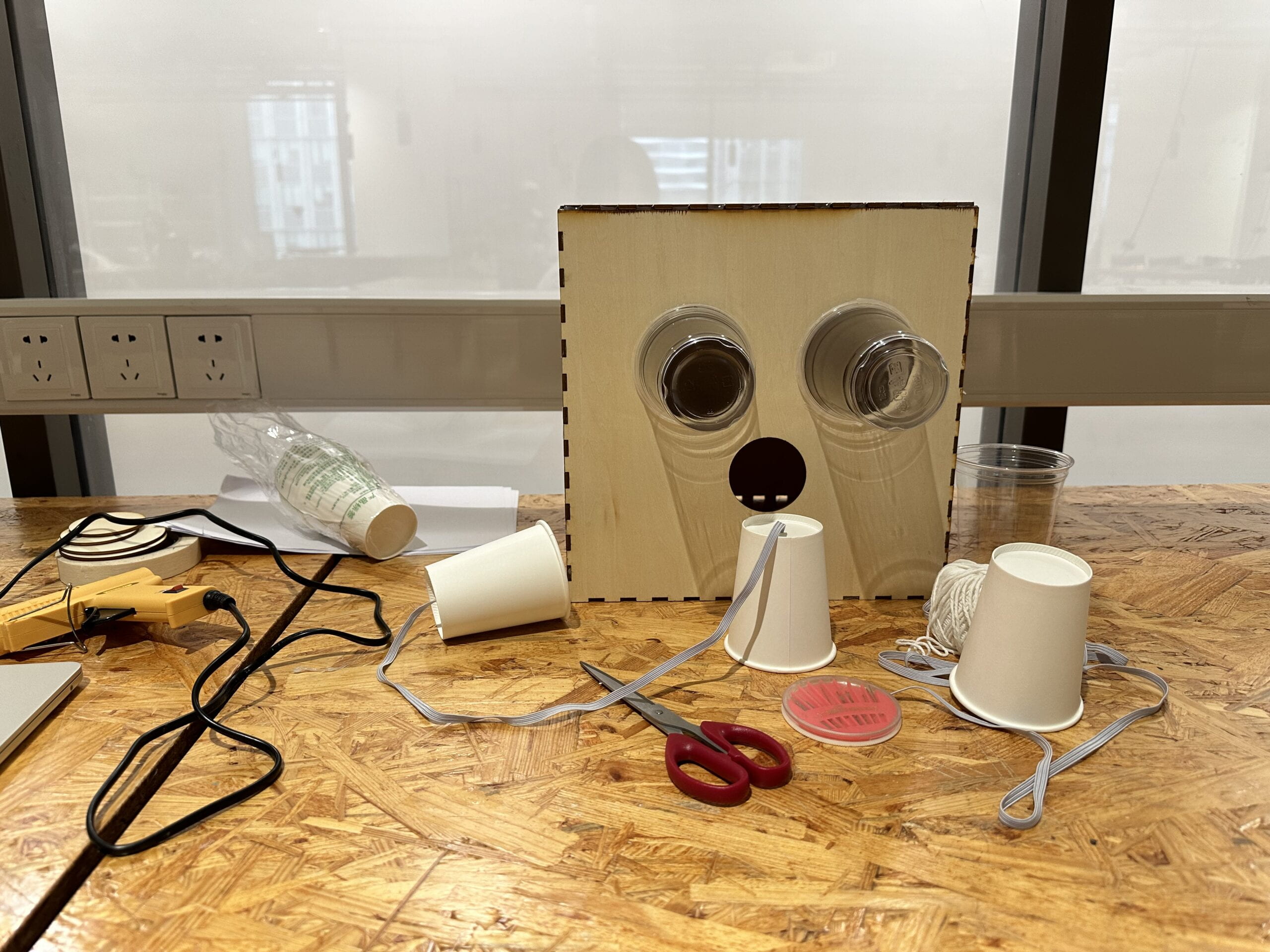
As my inspiration came from the idea of paper cup telephones, I also used strings to connect the paper cup located in the mouth position with the other two paper cups located near the ears. My intention was to make the sound travel through the string and therefore generate a stronger vibration and create a bigger sound (although later I figured out that it actually didn’t work), so I used a needle to poke a hole at the bottom of the paper cups and connected the three cups by elastic strings.
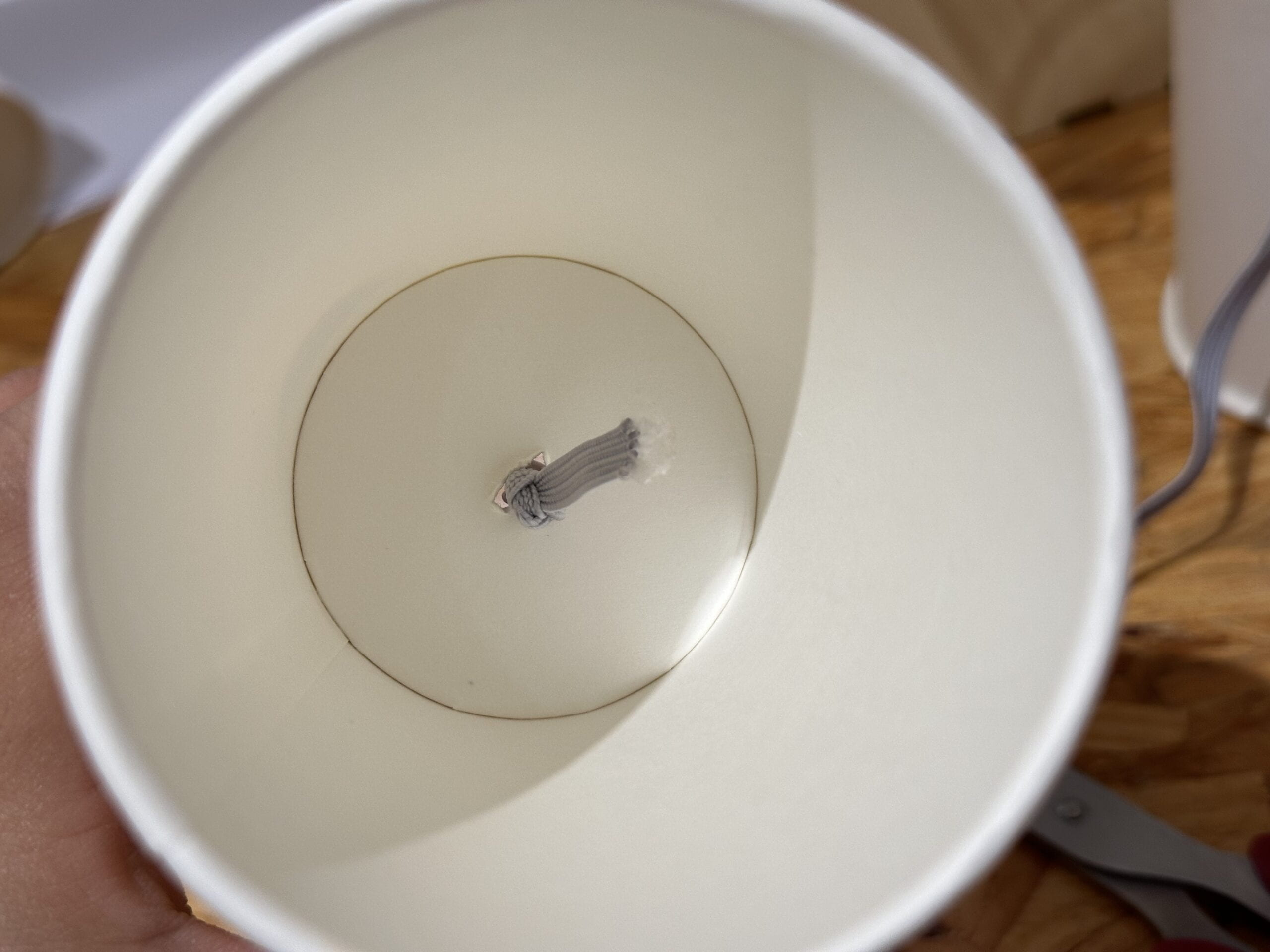
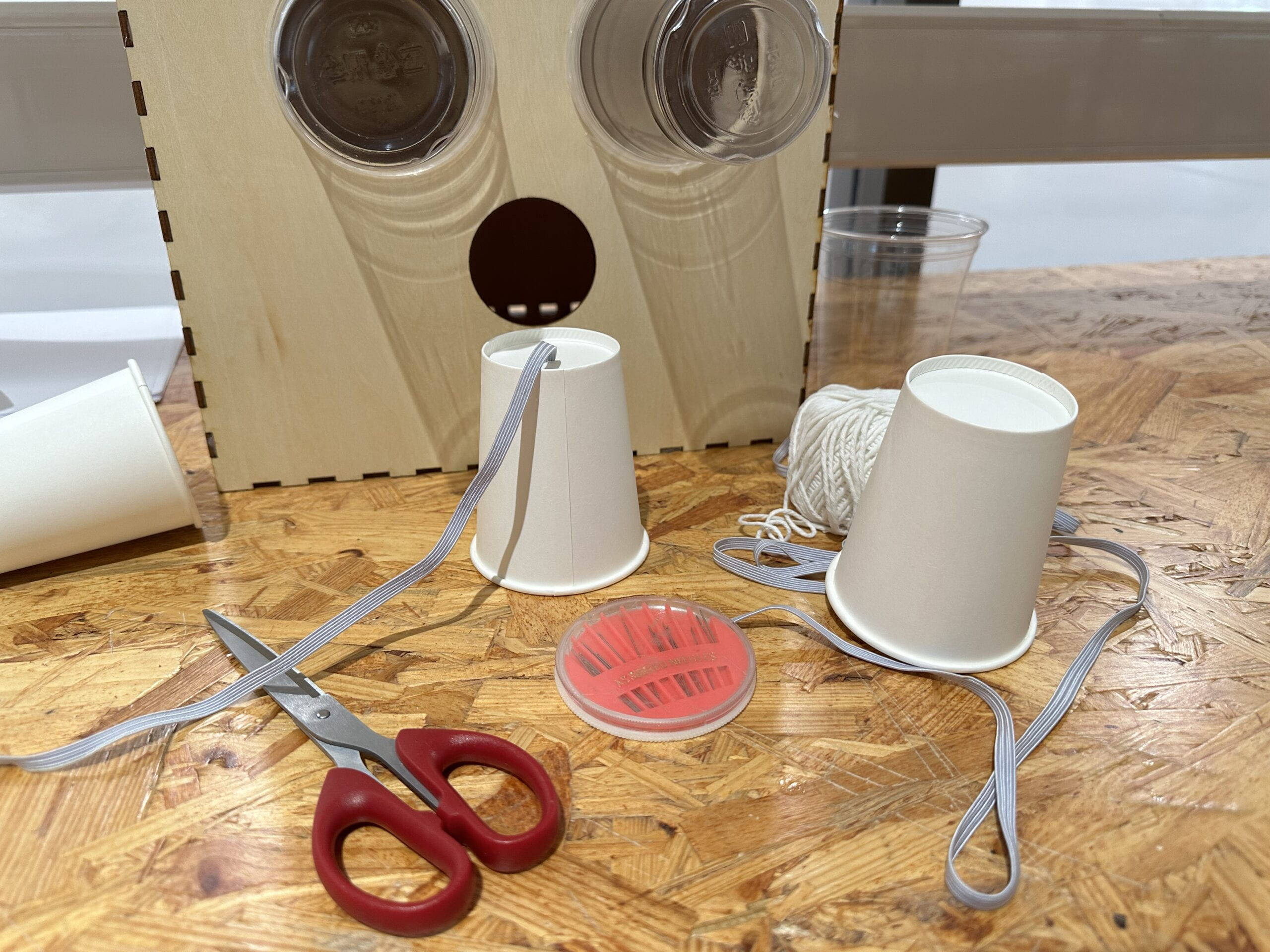
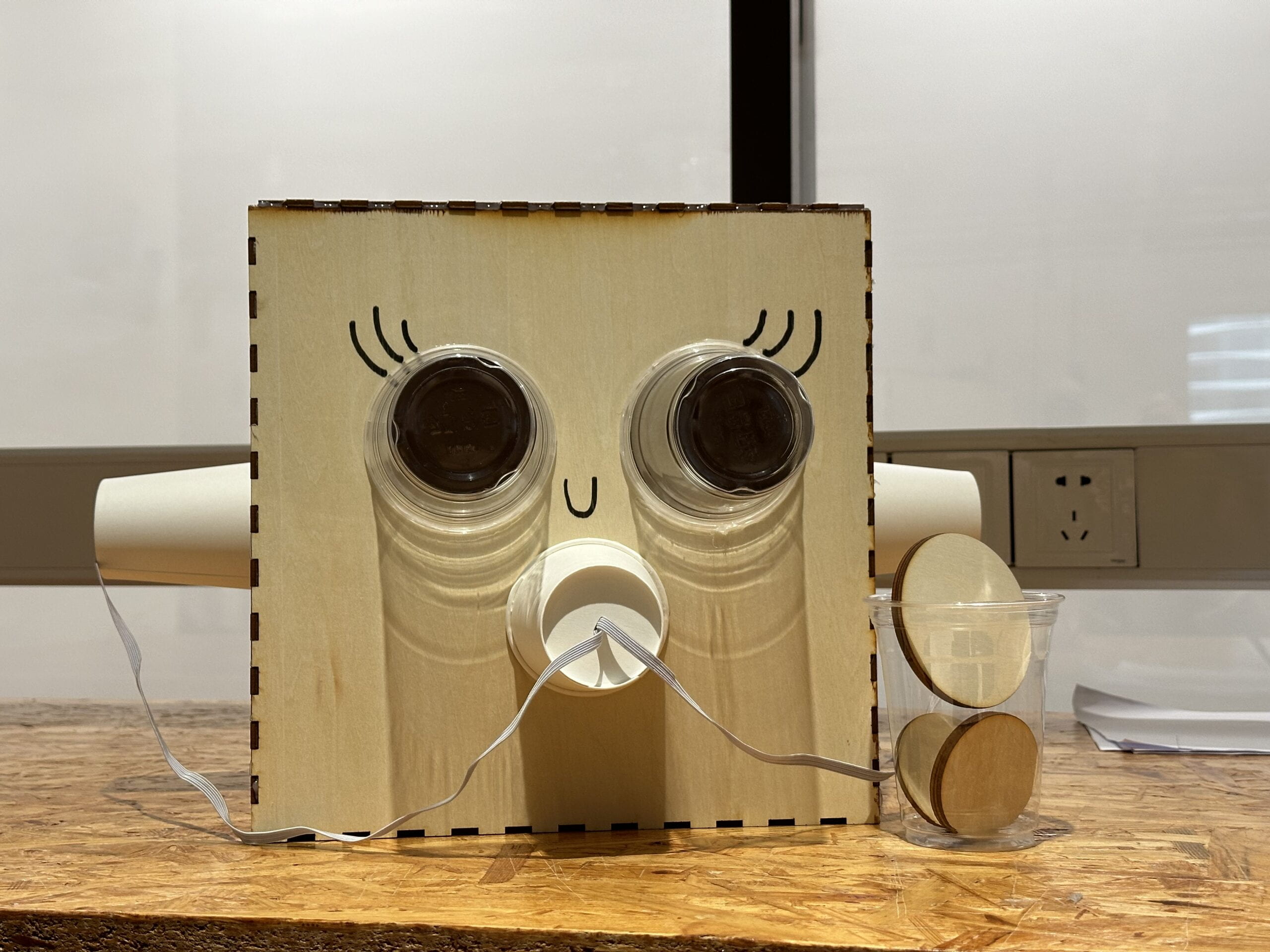
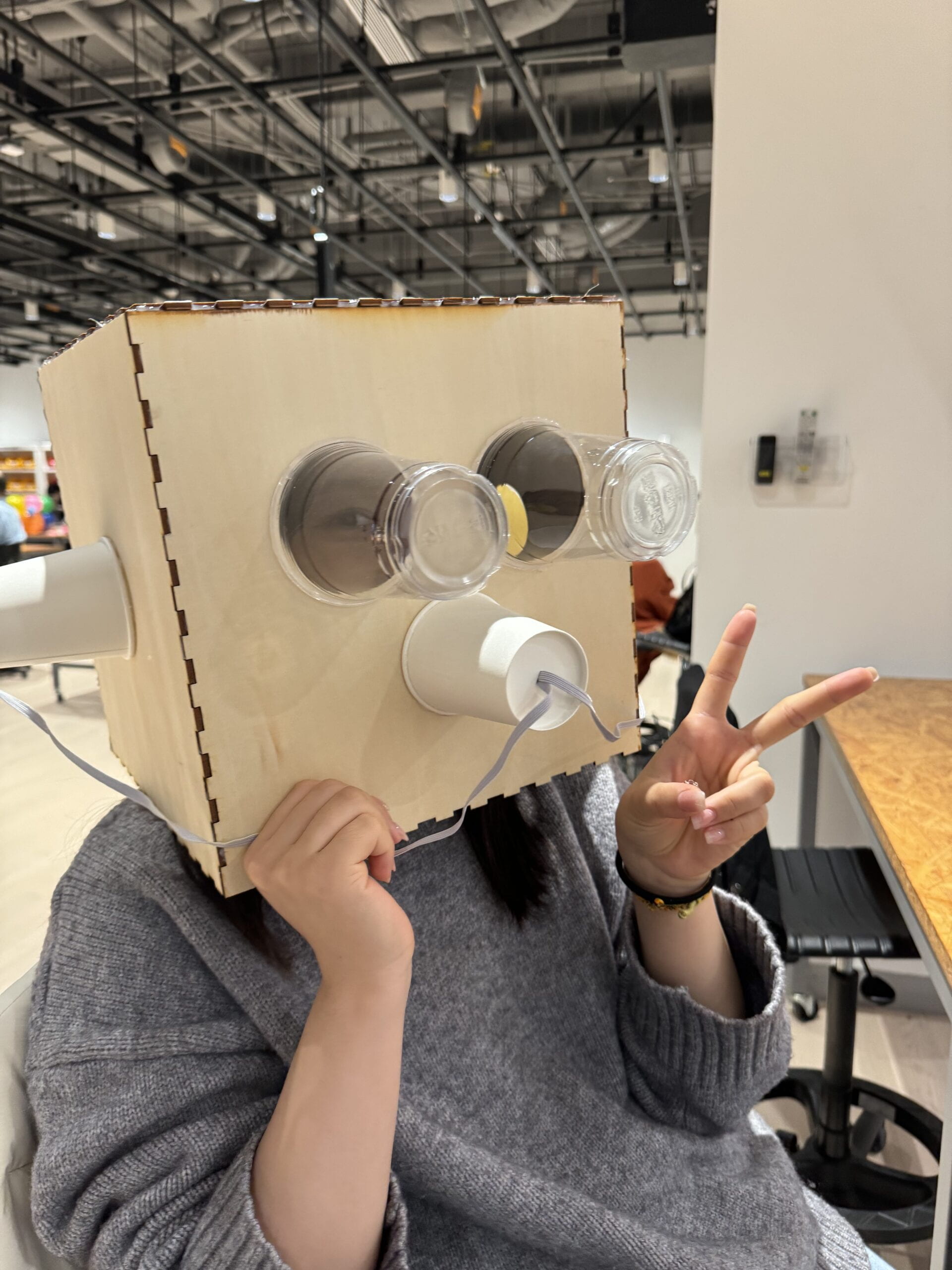
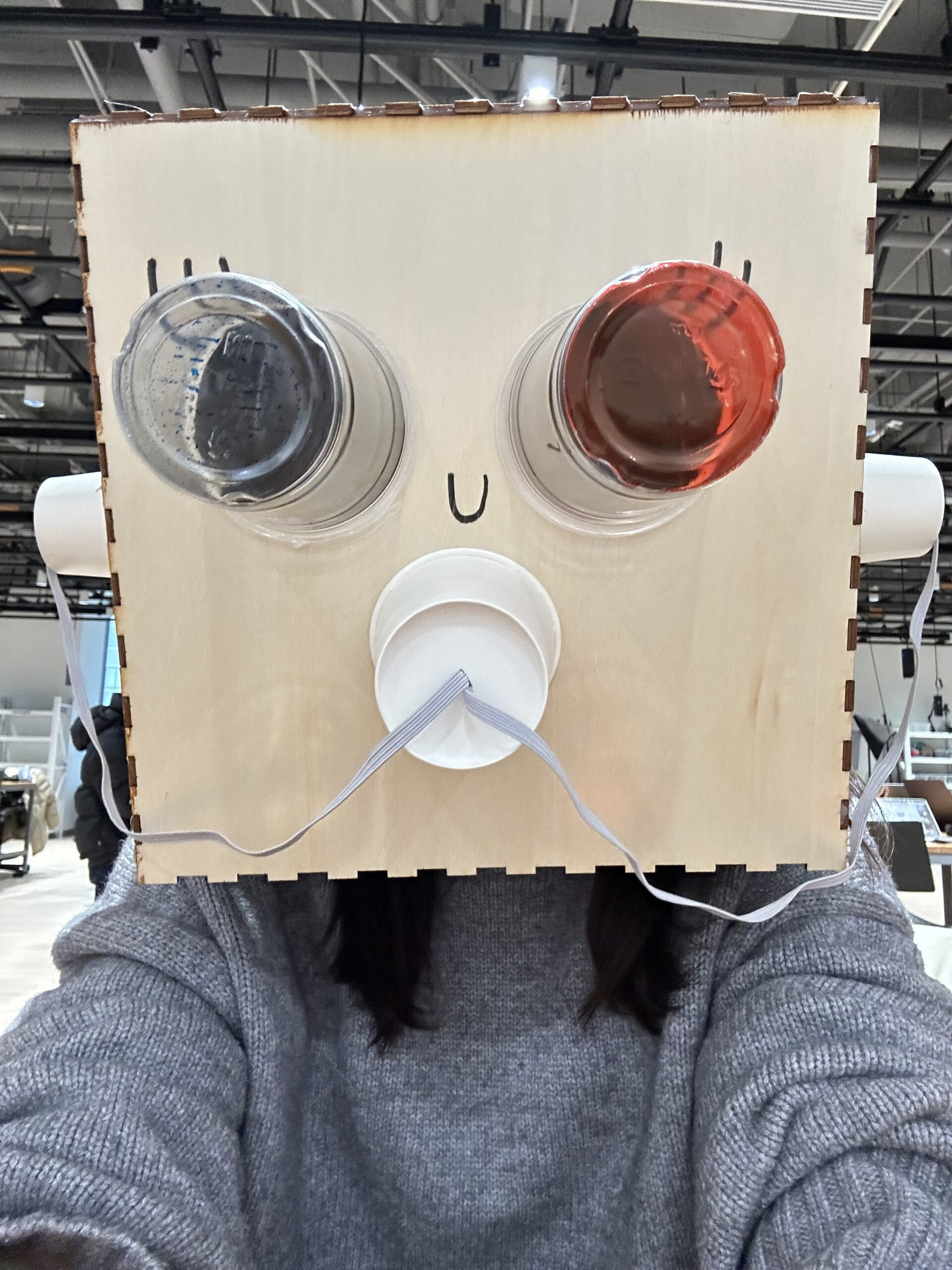
Later I tried the helmet myself, and it was easy for me to notice that the sound part worked much better than the vision part, since even though my sight was somehow distorted, I could still see what was happening outside, and the major difference would be that the range of my sight was limited to a smaller space. When it comes to the sound part, I think the echo effect worked well because I could hear that my voice was amplified due to the confined space created by wood boards and paper cups, and my friend who was with me at that time told me that it was blurrier to hear my voice from outside compared to the situation where I talked normally. Generally, this Echo Helmet is about putting the device on, temporarily cutting off from the external world, immersing oneself in the environment of being alone and therefore having time for introspection.
IV. Presentation
On the presentation day, before explaining how my project worked to my classmates, I first asked one of them to put the helmet on and say something to feel the vibration of his sound. When he was talking, for us who were not wearing the helmet, we could recognize that his sound became fuzzy, and he told us that he was able to hear the echoes of his own voice. Later other classmates tried the device too and reached similar effect.
There were still some things that I failed to anticipate. Firstly, even though I have mentioned previously that the “paper cup telephone” didn’t work, at this time I still believed that the strings played an important role when it came to sound transmission. However, during the presentation, my professor pointed out that the strings needed to be tight to transmit the sound, otherwise the sound vibration would not travel through the strings. He said that it was the wooden “walls” surrounding the person’s head instead of the paper cup telephone that had the effect of transmitting sound. Even though my intention went in the wrong way and didn’t lead to my ideal effect, at least I gained useful knowledge from this experience and was equipped with more knowledge that would help me with my future projects. Secondly, when designing this project, my idea was only to make it a wearable device and I didn’t expect any interaction besides talking. However, on the presentation day, many of my classmates started to knock on the helmet and play with the string. That inspired me a lot, because by making some sound on the helmet, it would sound differently to the person who was wearing it as well and reach the effect of amplifying hearing. So next time when I am trying to make a project, I will try to come up with ideas of how to make it more interactive and how I can engage more people in this project.
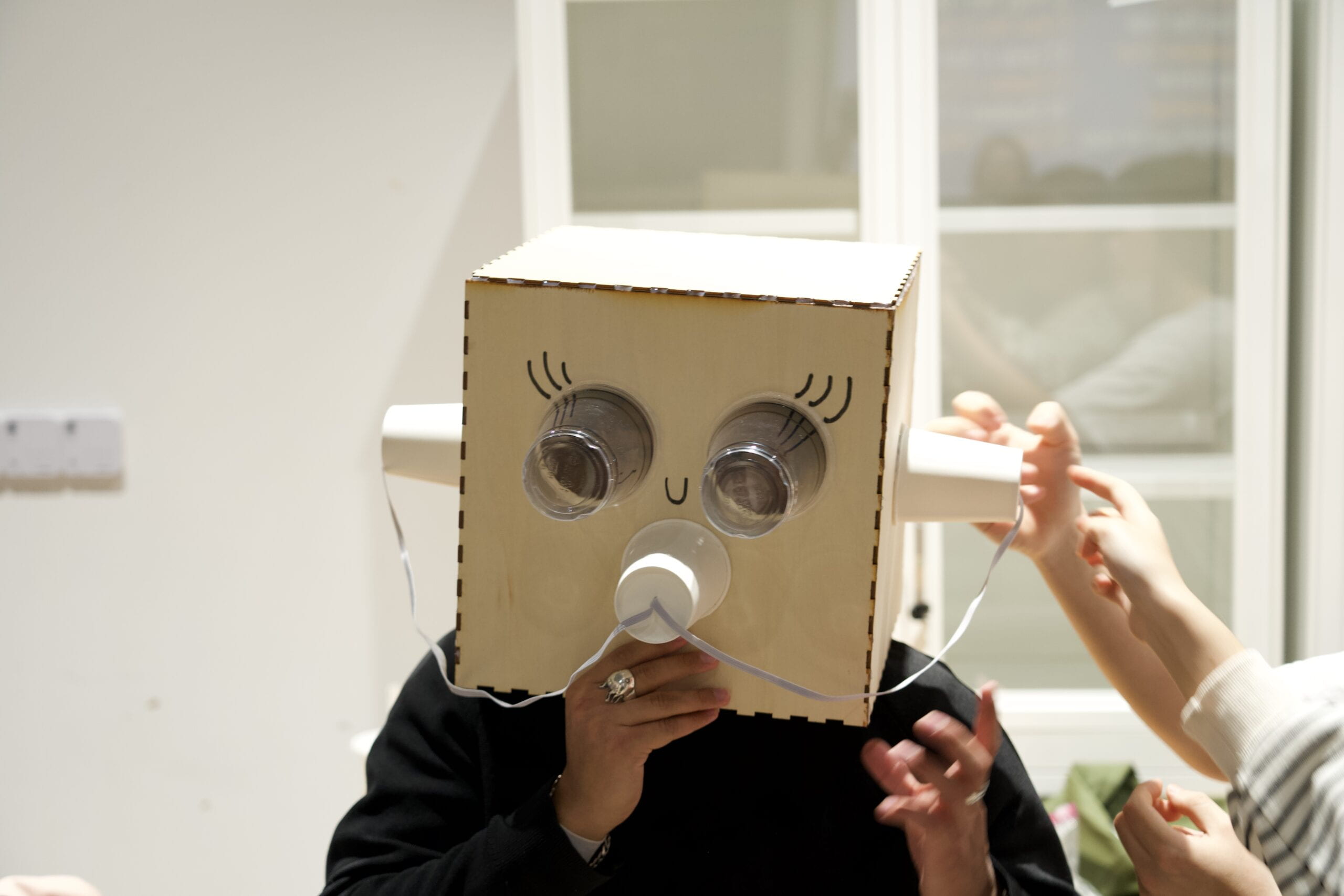
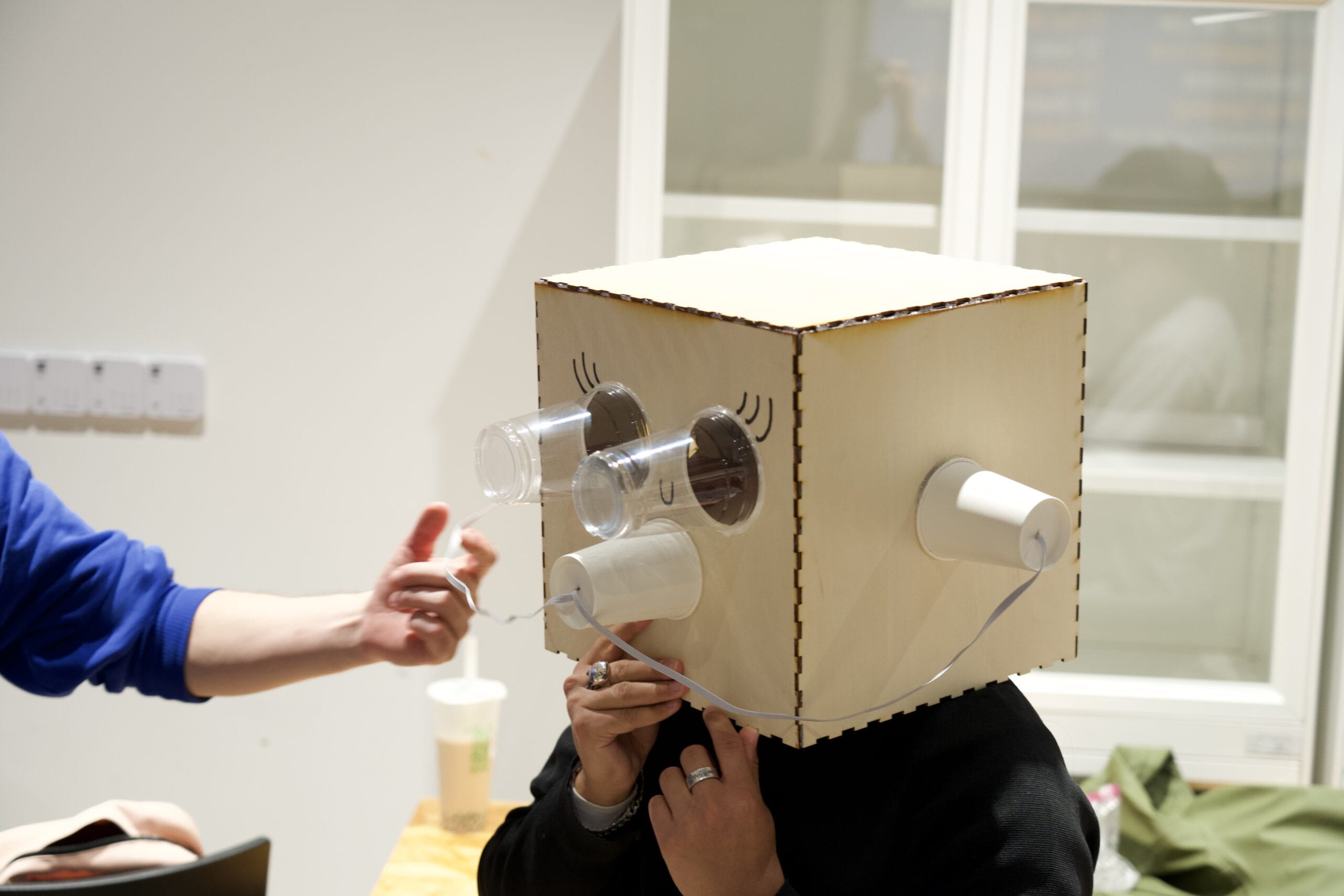

V. Conclusion
In general, this project helped me to have a broader and deeper knowledge about our sensory experiences and the perception. Thanks to the videos and the reading, I looked into the idea of synesthesia and had a better understanding of the importance of interaction between our bodies and the external world. Building on these concepts and looking back to my childhood when I used to play with the paper cup telephones, I decided to create a wearable device – the Echo Helmet – which can distort both hearing and vision of the user in a way that involves bodily engagement. In my opinion, in general this project has met my expectations at the beginning of the making process, but there are still many details that I would like to work on if I have more time.
When it comes to successes and failures, I think that my biggest success is that even though the string part turned out to be unsuccessful, the echo inside the helmet actually sounds good, so my prioritized goal of amplifying the sensory perceptions is met. However, I could have improved if I were more careful when it came to the tightness of the strings, and maybe I could do something else to the vision part to distort it to a greater extent. Most importantly, when coming up with ideas about the project, I could try to think deeper, reflect on the reading materials more and come up with a more interactive project which includes not only the engagement between the user and the outside world but also the interaction between other people and the user. That is the most crucial part that I would like to improve in the future.
Overall, I feel really grateful to engage in the developing process of this project and I have learned a lot of things during such work!

Leave a Reply